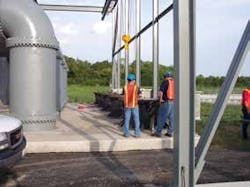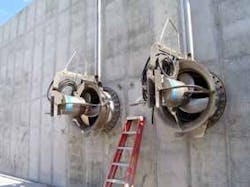Built in the 1980s, Little Blue Valley Sewer District operates Atherton, which was designed to reduce the primary process chain to preliminary bar screening and aerated grit removal, while relying solely on secondary treatment performed in four, standalone 42-ft by 400-ft aeration/clarification basins.
Scope
The $73-million retrofit changed the plant to a more conventional activated sludge process. The work included modification of two of the four existing oxidation ditches and mothballing the other two. Four, 1.48-MG primary clarifiers were built, along with five, 2.38-MG secondary clarifiers and an upgrade to the influent pump station. To correct discharge problems, a 640-hp, five-pump effluent pump station was built. This now allows four modes of operation, depending on the flow level.
Proven methods and technologies were applied, with an innovative combination of components.
The original plant design relied on mechanical mixers to maintain a 1 ft/second velocity in the 17-ft deep sewage flow as it circulated around the perimeter of the 6-MG oxidation ditches, which were configured with turning walls to further promote mixing. Almost from the outset, however, the process that had worked effectively elsewhere on a small scale was ill suited for the wet weather hydraulics of a plant as large as Atherton.
The original mixers were long-blade, variable speed, hydraulic-type units powered by external motors and hydraulic pumps. These mixers had become vulnerable. The motors and even their mounting masts began to fail. Maintenance costs skyrocketed as the mixers struggled to deliver a consistent velocity.
Solution
The district replaced the first-generation mixers with 16, Xylem 5-hp electric submersible mixers, arranged in a double battery of eight each at the ends of the channels. These submersible units were fitted with “banana blade” fiberglass props that rotated at 42 rpm to steadily propel and churn the mixed liquor suspended solids (MLSS) as it flowed around the channel.
The project increased the plant’s capacity from 40 mgd to 52 mgd average dry weather flow and partially addressed the issues associated with peaks. Some changes were subtle, such as maintaining deeper clarifiers or modifying two of the four oxidation basins. Others stood out, like the powerful effluent pump station with five, 100-mgd, Flygt Model PL7121, 640 hp propeller pumps. These pumps are equipped with a solids-handling “N” propeller that features a patented self-cleaning volute that clears the propeller of all debris that reaches the pumps.
After passing through the primary treatment, the flow enters the first zone of the basin where up to 30 percent of the primary effluent is pumped through the common wall by a propeller pump. This additional feed location allows the return activated sludge to achieve a higher system solids retention time without increasing the loading to the clarifiers. The PP4640, 4-hp pumps accomplish this task by simply pumping up to 7.8 mgd of the primary effluent through the common wall.
The sludge return (RAS) flow enters the first zone where it mixes with a separate entry of the primary effluent as well as MLSS at the end of the second pass through the basin. The flow first enters the basin where it can be operated as either an anoxic or an aerobic swing zone, depending on flow and treatment requirements. Two Flygt Model SR4680, 40-hp mixers work in conjunction with the flow from two PP4670, 20-hp recycle pumps to mix in this anoxic zone and provide homogenization of the influent, RAS, and recycled MLSS.
After the flow has traveled two passes through the basin and the ammonia has been oxidized, the two 20-hp pumps return the nitrified mixed liquor through the common wall. Each pump can advance 26 mgd to the anoxic zone increasing the nitrate load in where excess readily biodegradable carbon exists for denitrification.
Results
The system is adaptable and flexible enough to meet the state’s DNR discharge requirements when the utility confronts high peak flows of influent. The two remaining basins give this upgraded plant significant expansion capacity.
Now, the once challenged Atherton Plant steadily performs its mission, even with some rather challenging flow ranges.
Editor's Note: Scranton Gillette Communications and the SGC Water Group are not liable for the accuracy, efficacy and validity of the claims made in this piece. The views expressed in this content do not reflect the position of the editorial teams of Water & Wastes Digest, Water Quality Products and Storm Water Solutions.

